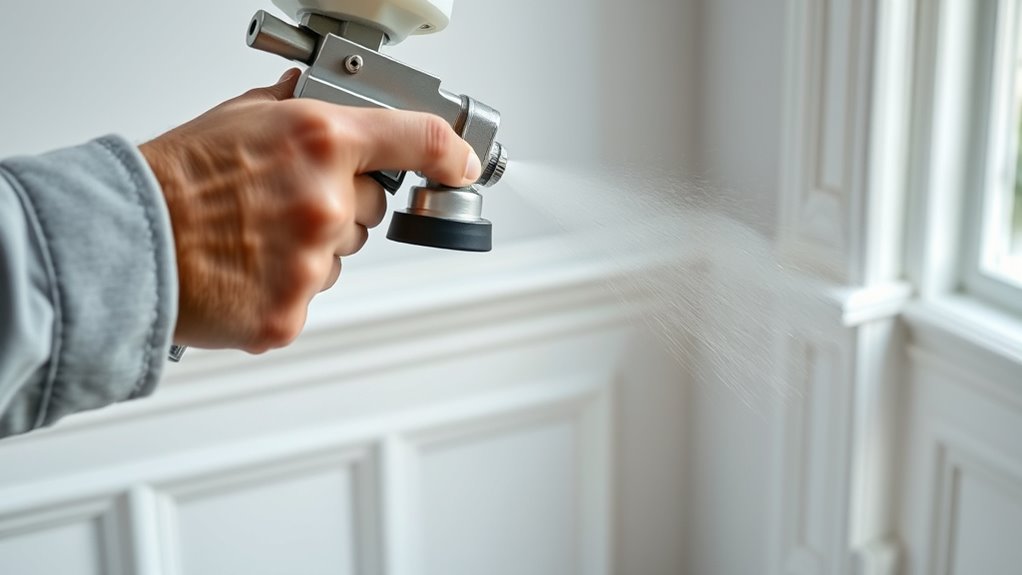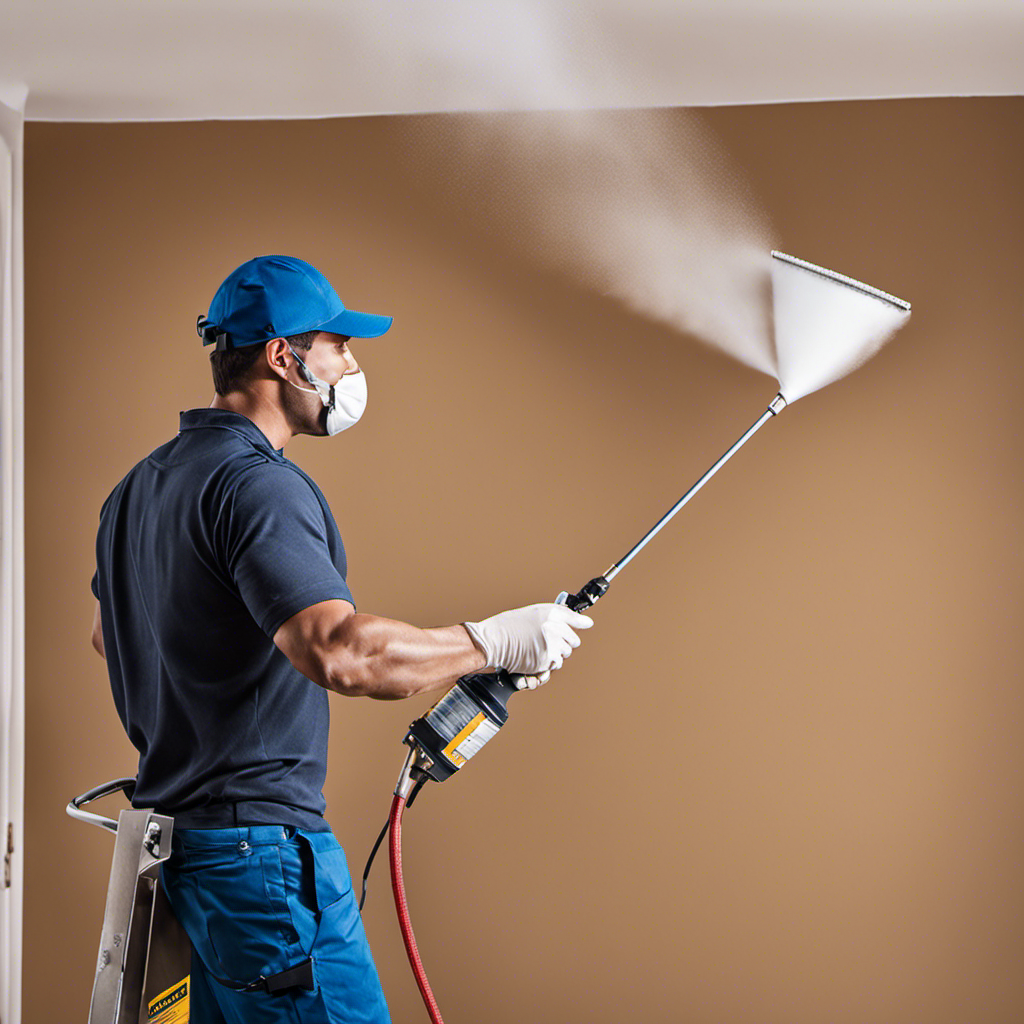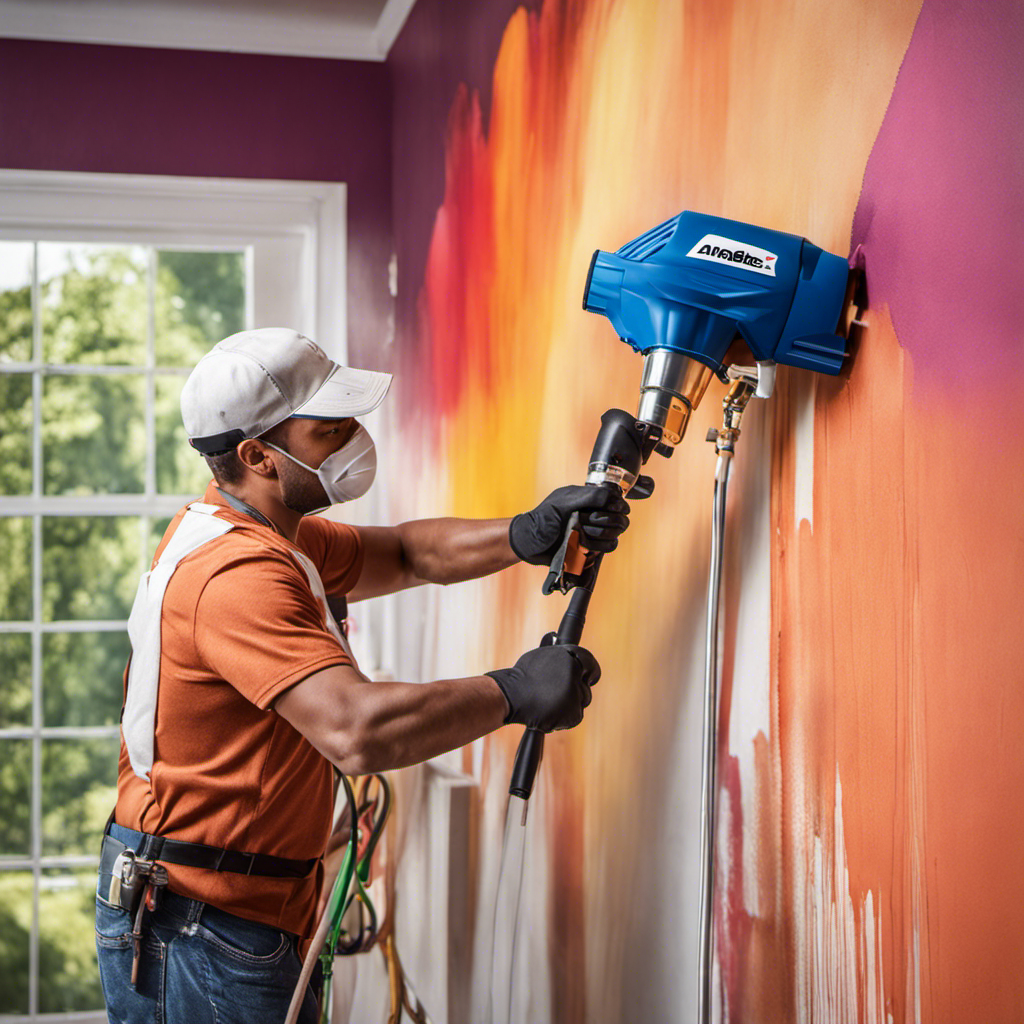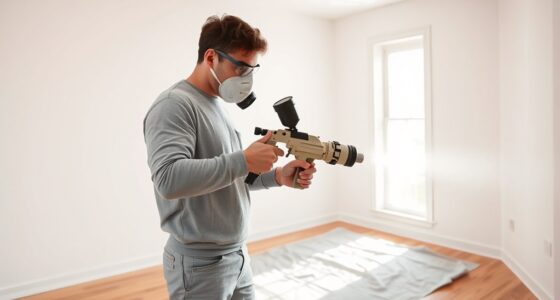To spray paint trim and baseboards like a pro, start with thorough surface prep by cleaning and sanding for smooth adhesion. Use painter’s tape to protect edges, then practice steady, consistent strokes to avoid drips and uneven coverage. Focus on maintaining a steady pace and keeping your spray at the right distance for smooth application. Finish with touch-ups with a brush for intricate areas. Keep these tips in mind, and you’ll master professional results in no time.
Key Takeaways
- Prep surfaces thoroughly by cleaning, sanding, and taping edges for smooth spray application.
- Use a high-quality spray gun with proper settings for even, professional coverage.
- Keep a consistent distance from surfaces and use smooth, overlapping passes to prevent drips and streaks.
- Use brushes for detailed areas and edges, blending seamlessly with spray-painted sections.
- Practice steady, controlled movements and wear protective gear for safety and precision.

Spray painting trim and baseboards is an efficient way to achieve a smooth, professional finish with minimal effort. Before you get started, proper paint preparation is essential. This means cleaning the surfaces thoroughly to remove dust, dirt, and grease, which can interfere with adhesion. Use a mild detergent and a damp cloth to wipe down the trim and baseboards, then let them dry completely. Sanding the surfaces lightly with fine-grit sandpaper ensures better paint adherence and smoothness. After sanding, wipe away any dust with a tack cloth or a damp rag, and apply painter’s tape along edges and adjoining surfaces to prevent overspray. Good paint preparation sets the foundation for a flawless finish.
Once your surfaces are prepped, focus on your brush techniques if you prefer or need to do any touch-ups or detailed work. Using a high-quality brush for edges and corners allows you to control the paint application precisely. Dip the brush just enough to coat the bristles without overloading it, which can cause drips. Use long, smooth strokes, working in the direction of the wood grain or the trim’s natural lines. Feather out the paint to blend edges seamlessly. This technique helps prevent brush marks and ensures a more uniform appearance. Keep a damp cloth nearby to wipe excess paint from your brush if needed, and work quickly to avoid paint drying on the bristles, which can lead to uneven coverage.
Even though spray painting is your primary method, brush techniques come in handy for achieving fine detail work or correcting streaks. When using a brush, avoid pressing too hard, which can leave visible marks. Instead, use light, consistent strokes, and maintain a wet edge to prevent lap marks. For baseboards with intricate details, a small angled brush can help you reach tight corners and edges, giving a professional look. Remember, the key is patience and steady handwork, especially around corners and edges where overspray can be tricky to control.
Frequently Asked Questions
What Type of Spray Paint Is Best for Trim and Baseboards?
You should choose a high-quality latex or oil-based spray paint for trim and baseboards. For a smooth finish, consider a semi-gloss or satin finish, which are popular options for trim. Make sure to use a compatible primer, like a bonding or stain-blocking primer, to guarantee the paint adheres well and lasts. This combo provides a professional look with a durable, easy-to-clean surface.
How Do I Prevent Drips and Overspray During Spray Painting?
To prevent drips and overspray, you should use proper brushing techniques to smooth out paint and avoid buildup. Mask off areas with painter’s tape and plastic sheeting to protect surfaces, and make sure you hold the spray gun at the correct distance. Keep your movements steady and overlapping slightly, and practice on scrap before starting. Proper masking tips and controlled spray application help achieve a clean, professional finish with minimal mess.
Can I Spray Paint Over Existing Painted Trim and Baseboards?
Yes, you can spray paint over existing painted trim and baseboards. First, prepare the surface by cleaning and lightly sanding it to guarantee good adhesion. Then, select the right spray paint for the material and finish. Proper paint preparation and choosing the correct spray paint selection help achieve a smooth, durable finish. Just make sure to mask off surrounding areas and apply thin, even coats for the best results.
How Long Should I Wait Before Applying a Second Coat?
Most spray paints need about 1 to 2 hours to dry before you can recoat, according to industry standards. That’s roughly the recoat interval you should wait before applying a second coat. Keep in mind, drying time varies with humidity and temperature. For best results, check the paint’s label for specific drying times and confirm the first coat is fully dry to avoid smudging or uneven coverage.
What Safety Precautions Are Necessary When Spray Painting Indoors?
When spray painting indoors, you need to prioritize safety by wearing protective gear like masks, goggles, and gloves to avoid inhaling fumes. Make certain your ventilation setup is effective by opening windows and using fans to circulate fresh air. Always work in a well-ventilated area, and consider using a respirator for added protection. These precautions help keep you safe while achieving a professional finish.
Conclusion
Now, armed with spray paint and confidence, you’re ready to transform your trim and baseboards from dull to stunning. It’s easy to make mistakes, but remember, perfection isn’t the goal—progress is. Think of the messy spray as your canvas’s rough draft, and your patience as the fine brush that brings it all together. With each stroke, you’re not just painting; you’re creating a polished masterpiece from chaos, turning a simple space into something truly special.
Franz came aboard the Paint Sprayer Zone team with a background in both journalism and home renovation. His articulate writing style, combined with a passion for DIY projects, makes him an invaluable asset. Franz has a knack for breaking down technical jargon into easy-to-understand content, ensuring that even the most novice of readers can grasp the complexities of paint sprayers.










